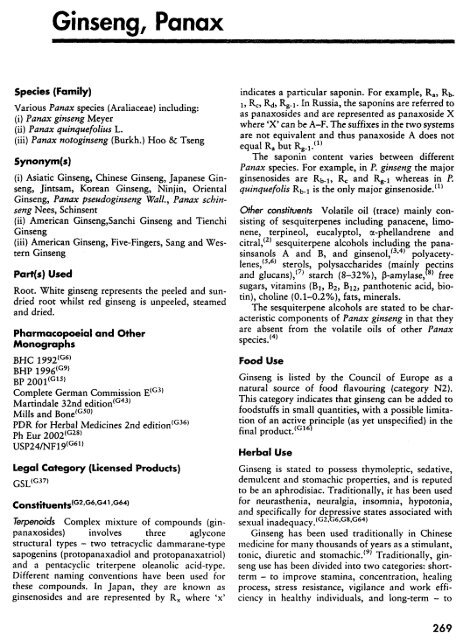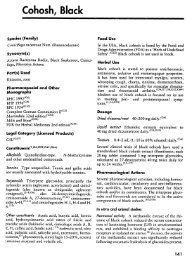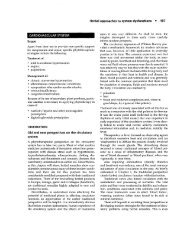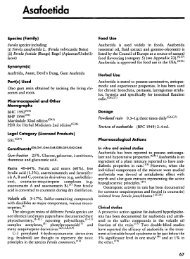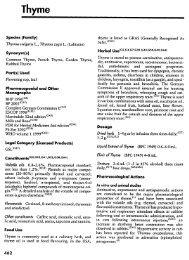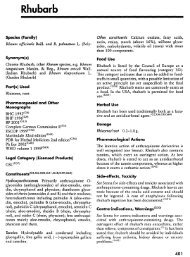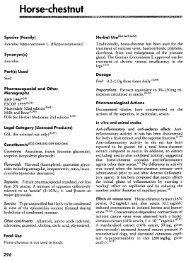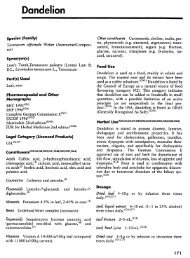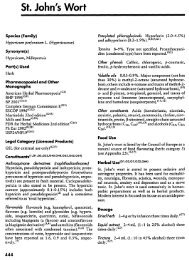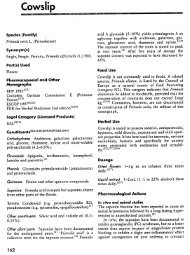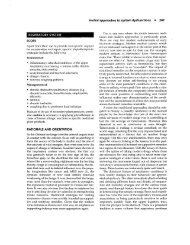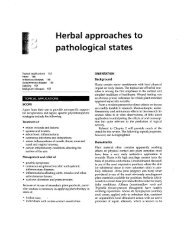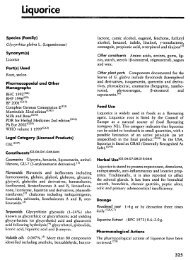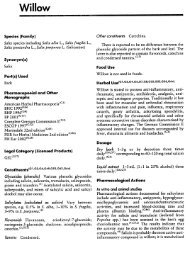Ginseng, Panax Species (Family)
Ginseng, Panax Species (Family)
Ginseng, Panax Species (Family)
You also want an ePaper? Increase the reach of your titles
YUMPU automatically turns print PDFs into web optimized ePapers that Google loves.
<strong>Ginseng</strong>, <strong>Panax</strong><br />
<strong>Species</strong> (<strong>Family</strong>)<br />
Various <strong>Panax</strong> species (Araliaceae) including :<br />
(i) <strong>Panax</strong> ginseng Meyer<br />
(ii) <strong>Panax</strong> quinquefolius L.<br />
(iii) <strong>Panax</strong> notoginseng (Burkh .) Hoo & Tseng<br />
Synonym(s)<br />
(i) Asiatic <strong>Ginseng</strong>, Chinese <strong>Ginseng</strong>, Japanese <strong>Ginseng</strong>,<br />
Jintsam, Korean <strong>Ginseng</strong>, Ninjin, Oriental<br />
<strong>Ginseng</strong>, <strong>Panax</strong> pseudoginseng Wall ., <strong>Panax</strong> schinseng<br />
Nees, Schinsent<br />
(ii) American <strong>Ginseng</strong>,Sanchi <strong>Ginseng</strong> and Tienchi<br />
<strong>Ginseng</strong><br />
(iii) American <strong>Ginseng</strong>, Five-Fingers, Sang and Western<br />
<strong>Ginseng</strong><br />
Part(s) Used<br />
Root . White ginseng represents the peeled and sundried<br />
root whilst red ginseng is unpeeled, steamed<br />
and dried .<br />
Pharmacopoeial and Other<br />
Monographs<br />
BHC 1992 (G6)<br />
BHP 1996 (G9)<br />
BP 2001 (G1s)<br />
Complete German Commission E (G3)<br />
Martindale 32nd edition (G43)<br />
Mills and Bone (G50)<br />
PDR for Herbal Medicines 2nd edition (G36)<br />
Ph Eur 2002 (G28)<br />
USP24/NF19 (G61)<br />
Legal Category (Licensed Products)<br />
GSL (G37)<br />
Constituents (G2,G6,G41,G64)<br />
Terpenoids Complex mixture of compounds (ginpanaxosides)<br />
involves three aglycone<br />
structural types - two tetracyclic dammarane-type<br />
sapogenins (protopanaxadiol and protopanaxatriol)<br />
and a pentacyclic triterpene oleanolic acid-type .<br />
Different naming conventions have been used for<br />
these compounds . In Japan, they are known as<br />
ginsenosides and are represented by R, where `x'<br />
indicates a particular saponin . For example, R a , Rb-<br />
1, Rc , Rd, Rg - 1 . In Russia, the saponins are referred to<br />
as panaxosides and are represented as panaxoside X<br />
where `X' can be A-F. The suffixes in the two systems<br />
are not equivalent and thus panaxoside A does not<br />
equal R a but Rg-1, (1)<br />
The saponin content varies between different<br />
<strong>Panax</strong> species . For example, in P. ginseng the major<br />
ginsenosides are Rb_ 1, Rc and Rg _ 1 whereas in P.<br />
quinquefolis Rb-1 is the only major ginsenoside . (I)<br />
Other constituents Volatile oil (trace) mainly consisting<br />
of sesquiterpenes including panacene, limonene,<br />
terpineol, eucalyptol, a-phellandrene and<br />
citral '(2) sesquiterpene alcohols including the panasinsanols<br />
A and B, and ginsenol, (3 .4) polyacetylenes,<br />
(5 .6 ) sterols, polysaccharides (mainly pectins<br />
and glucans) ' (7) starch (8-32%), (i-amylase, 8) free<br />
sugars, vitamins (B 1 , B2 , B 12 , panthotenic acid, biotin),<br />
choline (0 .1-0 .2%), fats, minerals .<br />
The sesquiterpene alcohols are stated to be characteristic<br />
components of <strong>Panax</strong> ginseng in that they<br />
are absent from the volatile oils of other <strong>Panax</strong><br />
species . (4)<br />
Food Use<br />
<strong>Ginseng</strong> is listed by the Council of Europe as a<br />
natural source of food flavouring (category N2) .<br />
This category indicates that ginseng can be added to<br />
foodstuffs in small quantities, with a possible limitation<br />
of an active 6l~rinciple (as yet unspecified) in the<br />
(G'<br />
final product .<br />
Herbal Use<br />
<strong>Ginseng</strong> is stated to possess thymoleptic, sedative,<br />
demulcent and stomachic properties, and is reputed<br />
to be an aphrodisiac . Traditionally, it has been used<br />
for neurasthenia, neuralgia, insomnia, hypotonia,<br />
and specifically for depressive states associated with<br />
(G2, G6,G8,G64)<br />
sexual inadequacy .<br />
<strong>Ginseng</strong> has been used traditionally in Chinese<br />
medicine for many thousands of years as a stimulant,<br />
tonic, diuretic and stomachic . (9) Traditionally, ginseng<br />
use has been divided into two categories : shortterm<br />
- to improve stamina, concentration, healing<br />
process, stress resistance, vigilance and work efficiency<br />
in healthy individuals, and long-term - to<br />
269
270 <strong>Ginseng</strong>, <strong>Panax</strong><br />
improve well-being in debilitated and degenerative<br />
conditions especially those associated with old age .<br />
Dosage<br />
Traditionally, dosage recommendations differ<br />
between the short-term use in healthy individuals<br />
and the long-term use in elderly or debilitated persons<br />
.<br />
Short-term (for the young and healthy) 0 .5-1 .0 g root<br />
daily, as two divided doses, for a course generally<br />
lasting 15-20 days and with a root-free period of<br />
approximately two weeks between consecutive<br />
courses . Doses are recommended to be taken<br />
in the morning, 2 hours before a meal, and in the<br />
evening, not less than 2 hours after a meal .' 9)<br />
Long-term (for the old and sick) 0 .4-0 .8 g root daily .<br />
Doses may be taken continuously . (1)<br />
Pharmacological Actions<br />
In the 1950s, early studies on ginseng reported its<br />
ability to improve both physical endurance and<br />
mental ability in animals and humans . ( ' O) In addition,<br />
the `tonic' properties of ginseng were confirmed<br />
by the observation that doses taken for a prolonged<br />
period of time increased the overall well-being of an<br />
individual, measured by various parameters such as<br />
appetite, sleep and absence of moodiness, resulting<br />
in an increased work efficiency . Furthermore, these<br />
effects were felt for some time after cessation of<br />
ginseng treatment . (10) In addition, gonadotrophic<br />
activity, slight anti-inflammatory activity and an<br />
effect on carbohydrate metabolism were noted." )<br />
Since then, numerous studies have investigated the<br />
complex pharmacology of ginseng in both animals<br />
and humans . The saponin glycosides (ginsenosides/<br />
panaxosides) are generally recognised as the main<br />
active constituents in ginseng, although pharmacological<br />
activities have also been associated with nonsaponin<br />
components.<br />
The following sections on animal and human<br />
studies are intended to give an indication of the<br />
type of research that has been published for ginseng<br />
rather than to provide a comprehensive bibliography<br />
of ginseng research papers .<br />
In vitro and animal studies<br />
Corticosteroid-like activity Many of the activities<br />
exhibited by <strong>Panax</strong> ginseng have been compared to<br />
corticosteroid-like actions and results of endocrinological<br />
studies have suggested that the ginsenosides<br />
may primarily augment adrenal steroidogenesis via<br />
an indirect action on the pituitary gland . (" ) Ginsenosides<br />
have increased adrenal cAMP in intact but not<br />
in hypophysectomised rats and dexamethasone, a<br />
synthetic glucocorticoid that provides positive feedback<br />
at the level of the pituitary gland, has blocked<br />
the effect of ginsenosides on pituitary corticotrophin<br />
and adrenal corticosterone secretion ." ) Hormones<br />
produced by the pituitary and adrenal glands are<br />
known to play a significant role in the adaptation<br />
capabilities of the body . (12) Working capacity is one<br />
of the indices used to measure adaptation ability and<br />
ginseng has been shown to increase the working<br />
capacity of rats following single (132%) and sevenday<br />
(179%) administration (intraperitoneal) .<br />
Furthermore, seven-day administration of ginseng<br />
decreased the reduction seen in working capacity<br />
when the pituitary-adrenocortical system is blocked<br />
by prior administration of hydrocortisone . (12)<br />
Hypoglycaemic activity Hypoglycaemic activity has<br />
been documented for ginseng and attributed to both<br />
saponin and polysaccharide constituents . In vitro<br />
studies using isolated rat pancreatic islets have<br />
shown that ginsenosides promote an insulin release<br />
which is independent of extracellular calcium and<br />
which utilises a different mechanism to that of<br />
glucose . (13) In addition, in vivo studies in rats have<br />
reported that a ginseng extract increases the number<br />
of insulin receptors in bone marrow and reduces the<br />
number of . lucocorticoid receptors in rat brain<br />
homogenate '14) Both of these actions are thought<br />
to contribute to the antidiabetic action of ginseng, in<br />
view of the known diabetogenic action of adrenal<br />
corticoids and the knowledge that the number of<br />
(14)<br />
insulin receptors generally decreases with ageing .<br />
Hypoglycaemic activity observed in both normal<br />
and alloxan-induced hyperglycaemic mice administered<br />
ginseng (intraperitoneal) has also been attributed<br />
to non-saponin but uncharacterised<br />
principles" 5-18) and to glycan (polysaccharide) components,<br />
<strong>Panax</strong>ans A-E and Q-U . (19-23) Glycans<br />
isolated from Korean ginseng or Chinese ginseng<br />
(A-E) were found to possess stronger hypoglycaemic<br />
activity than those isolated from Japanese ginseng<br />
(Q-U) . (23) Proposed mechanisms of action have<br />
included elevated plasma insulin concentration due<br />
to an increase of insulin secretion from pancreatic<br />
islets, and enhancement of insulin sensitiviry .<br />
However, these mechanisms do not explain the<br />
total hypoglycaemic activity that has been exhibited<br />
by the polysaccharides and further mechanisms are<br />
under investigation . (21)<br />
The effect of panaxans A and B on the activities of<br />
key enzymes participatin in carbohydrate metabo -<br />
lism has been studied . (181 DPG-3-2, a non-saponin
<strong>Ginseng</strong>, Ponox 271<br />
component isolated from ginseng, has been shown to<br />
stimulate insulin biosynthesis in pancreatic preparations<br />
from various hyperglycaemic (but not<br />
normoglycaemic) animals ; ginsenosides Rb 1 and<br />
Rg, were found to decrease islet insulin concentrations<br />
to an undetectable level . (")<br />
Cardiovascular activity Individual saponins have<br />
been reported to have different actions on cardiac<br />
haemodynamics . (24) For instance R g, Rg- 1 and total<br />
flower saponins have increased cardiac performance<br />
whilst Rb and total leaf saponins have decreased it ;<br />
calcium antagonist activity has been reported for Rb<br />
but not for Rg; Rb but not Rg has produced a<br />
protective effect on experimental myocardial infarction<br />
in rabbits . (24) Negative chronotropic and inotropic<br />
effects in vitro have been observed for ginseng<br />
saponins and a mechanism of action similar to that of<br />
verapamil has been suggested . (21) In vitro studies on<br />
the isolated rabbit heart have reported an increase in<br />
coronary blood flow together with a positive inotropic<br />
effect . (26) Anti-arrhythmic action on aconitine<br />
and barium chloride (rat) and adrenaline (rabbit)-<br />
induced arrhythmias, and prolongation of RR, PR<br />
and QTc intervals (rat), have been documented for<br />
saponins R c- 1 and Rd- 1 . The mode of action was<br />
thought to be similar to that of amiodarone . (27)<br />
Ginsenosides (i .p.) have been reported to protect<br />
mice against metabolic disturbances and myocardial<br />
damage associated with conditions of severe<br />
(28)<br />
anoxia .<br />
<strong>Ginseng</strong> has produced a marked hypotensive<br />
response together with bradycardia following intravenous<br />
administration to rats . The dose-related effect<br />
was blocked by many antagonists suggesting multisite<br />
activity. (26) Higher doses of ginseng were found<br />
to cause vasoconstriction rather than vasodilation in<br />
renal, mesenteric and femoral arteries . (26)<br />
The total ginseng saponin fraction has been<br />
reported to be devoid of haemolytic activity . However,<br />
individual ginsenosides have been found to<br />
exhibit either haemolytic or protective activities .<br />
Protective ginsenosides include R c , Rb_2 and R e ,<br />
whereas haemolytic saponins have included R g. Rh<br />
and R f.(29) The number and position of sugars<br />
attached to the sapogenin moiety was thought to<br />
determine activity . 9) Haemostatic activity has also<br />
been documented for ginseng . (30)<br />
Oral administration of ginseng to rats fed a high<br />
cholesterol diet reduced serum cholesterol and triglycerides,<br />
increased high-density lipoprotein (HDL)<br />
cholesterol, decreased platelet adhesiveness, and<br />
decreased fatty changes to the liver. (31) <strong>Ginseng</strong> has<br />
also been reported to reduce blood coagulation and<br />
enhance fibrinolysis . (32) <strong>Panax</strong>ynol and the ginseno-<br />
sides R0, Rg_ 1 and Rg __ have been documented as the<br />
main antiplatelet components in ginseng inhibiting<br />
aggregation, release reaction and thromboxane formation<br />
in vitro . 2 ) Anti-inflammatory activity and<br />
inhibition of thromboxane B 2 have previously been<br />
described for panaxynol . 02) Anticomplementary<br />
activity in vitro (human serum) has been documented<br />
for ginseng polysaccharides with highest activity<br />
observed in strongly acidic polysaccharide fractions<br />
. (7)<br />
Effects on neurotransmitters Studies in rats have<br />
shown that a standardised ginseng extract (G115)<br />
inhibits the development of morphine tolerance and<br />
physical dependence, of a decrease in hepatic glutathione<br />
concentrations, and of dopamine receptor<br />
sensitivity without antagonising morphine analgesia,<br />
as previously documented for the individual saponins<br />
. (33) The inhibition of tolerance was thought to be<br />
associated with a reduction in morphinone production,<br />
a toxic metabolite which irreversibly blocks the<br />
opiate receptor sites, and with the activation of<br />
morphinone-glutathione conjugation, a detoxication<br />
process. The mechanism of inhibition of physical<br />
dependence was unclear but thought to be<br />
associated with changed ratios of adrenaline, noradrenaline,<br />
dopamine and serotonin in the brain' (33)<br />
A total ginsenoside fraction has been reported to<br />
inhibit the uptake of various neurotransmitters into<br />
rat brain synaptosomes in descending order of<br />
gamma-aminobutyrate and noradrenaline, dopamine,<br />
glutamate and serotonin . (34-36 ) The fraction<br />
containing ginsenoside Rd was most effective .<br />
Uptake of metabolic substrates 2-deoxy-D-glucose<br />
and leucine was only slightly affected and therefore<br />
it was proposed that the ginseng extracts were acting<br />
centrally rather than locally as surface active agents .<br />
Studies in rats have indicated that the increase in<br />
dopaminergic receptors in the brain observed under<br />
conditions of stress is prevented by pretreatment with<br />
ginseng . (37)<br />
Hepotoprotective activity Antoxidant and detoxifying<br />
activities have been documented for ginseng .<br />
(38)<br />
Protection against carbon tetrachloride- and<br />
galactosamine-induced hepatotoxicity has been<br />
observed in cultured rat hepatocytes for specific<br />
ginsenosides (oleanolic acid and dammarane series)<br />
.(38,39) However, at higher doses certain ginsenosides<br />
from both series were found to exhibit<br />
simultaneous cytotoxic activity . (36)<br />
Cytotoxic and ontitumour activity Cytotoxic activity<br />
(ED S 0 0 .5 pg/mL) versus L1210 has been documented<br />
for polyacetylenes isolated from the root . (5,6,40) The
272 <strong>Ginseng</strong>, <strong>Panax</strong><br />
antitumour effect of ginseng polysaccharides in<br />
tumour-bearing mice has been associated with an<br />
immunological mechanism of action . ~ 41) <strong>Ginseng</strong><br />
polysaccharides have been reported to increase the<br />
lifespan of tumour-bearing mice and to inhibit the<br />
growth of tumour cells in vivo, although cytocidal<br />
action was not seen in vitro . (41) Antitumour activity<br />
in vitro versus several tumour cell lines has been<br />
documented for a polyacetylene, panaxytriol . (42' )<br />
Antiviral activity Antiviral activity (versus Semliki<br />
forest virus ; 34-40% protection) has been documented<br />
for ginseng extract (G115,, Pharmaton) administered<br />
orally to rats . (37) The ginseng extract also<br />
enhanced the level of protection afforded by 6-<br />
MFA, an interferon-inducing agent of fungal origin<br />
. (43) <strong>Ginseng</strong> has been found to induce in vitro<br />
and in vivo production of interferon and to augment<br />
the natural killer and antibody dependent cytotoxic<br />
activities in human peripheral lymphocytes . (43,44) In<br />
addition, ginseng enhances the antibody-forming cell<br />
response to sheep red blood cells in mice and stimulates<br />
cell mediated immunity both in vitro and in<br />
vivo . (43,44) In view of these observations, it has been<br />
proposed that the antiviral activity of ginseng may be<br />
immunologically mediated . (43,44)<br />
Clinical studies<br />
Improvements in serum total cholesterol, HDL<br />
cholesterol, triglycerides, non-essential fatty acids<br />
and lipoperoxides have been observed in 67 hyperlipidaemic<br />
patients administered 2 .7 g/day red<br />
ginseng . (27) The addition of ginseng (3 g/65 kg<br />
body weight) to alcohol consumption (72 g/65 kg<br />
body weight of 25% ethanol) has been reported<br />
to enhance blood alcohol clearance by<br />
32-51 % . (45)<br />
A preparation containing ginseng extract with<br />
multivitamins and trace elements has been shown to<br />
modify some indices of metabolic and liver function<br />
in elderly patients with chronic hepatotoxicity<br />
induced by alcohol and drugs . (46) Patients who<br />
received ginseng exhibited an increase in bromosulphthalein<br />
excretion (which is related to hepatic<br />
detoxification) and improved serum zinc concentrations.<br />
(46)<br />
A favourable effect on various tests of psychomotor<br />
performance (attention, processing, integrated<br />
sensory motor function and auditory reaction time)<br />
in healthv individuals receiving a ginseng extract<br />
(200 mg daily for 12 weeks) has been documented<br />
in a double-blind placebo-controlled study . (") No<br />
difference was observed between ginseng and placebo<br />
groups in tests of pure motor function, recognition<br />
and visual reaction time . (47)<br />
<strong>Ginseng</strong> has been reported to improve the overall<br />
control of status asthmaticus when added to<br />
conventional steroid, bronchodilator and antibiotic<br />
therapies .<br />
(48)<br />
<strong>Ginseng</strong> has been shown to reduce blood sugar<br />
concentrations in both diabetics and non-diabetics, (l)<br />
such that in one study insulin therapy was no longer<br />
required in a proportion of the patients investigated<br />
. ( ' )<br />
<strong>Ginseng</strong> has also been reported to normalise both<br />
high and low blood pressure states .' )<br />
<strong>Ginseng</strong> has been found to affect concentrations<br />
of corticosteroids such as adrenocorticotrophic hormone<br />
(ACTH) and cortisol and noradrenaline . ( ' )<br />
<strong>Ginseng</strong> has been reported to successfully treat<br />
cases of diabetic polyneuropathy, reactive depression,<br />
psychogenic impotence, enuresis and various<br />
child psychiatric disorders . (49)<br />
Side-effects, Toxicity<br />
In Japan, ginseng (panax) has been given to more<br />
than 500 individuals over the course of two studies<br />
with no side-effects experienced ." ) However, suspected<br />
adverse events associated with ginseng treatment<br />
have been documented although it is often<br />
difficult to assess individual cases due to a lack of<br />
information concerning dose, duration of treatment,<br />
species of ginseng used, and concurrent medication<br />
.' ) Nevertheless, symptoms documented include<br />
hypertension" ) (ginseng species unspecified), diarrhoea,'<br />
) insomnia" ) (as a result of over stimulation),<br />
mastalgia, (l) skin eruptions" ) and vaginal<br />
bleeding" ) . A case of vaginal bleeding in a postmenopausal<br />
woman has been associated with the use of<br />
a ginseng face cream . (50) In 1979, two studies referred<br />
to a ginseng abuse syndrome (GAS) which emphasised<br />
that most side-effects documented for ginseng<br />
were associated with the ingestion of large doses of<br />
ginseng together with other psychomotor stimulants,<br />
including tea and coffee . GAS was defined as<br />
diarrhoea, hypertension, nervousness, skin eruptions<br />
and sleeplessness . Other symptoms occasionally<br />
observed included amenorrhoea, decreased appetite,<br />
depression, euphoria, hypotension and oedema .<br />
However, these two studies have been widely criticised<br />
over the variety of ginseng and other preparations<br />
used, and over the lack of authentication of the<br />
ginseng species ingested ." ) Elsewhere, symptoms of<br />
overdose have been described as those exhibited by<br />
individuals allergic to ginseng, namely palpitations,<br />
insomnia and pruritus, together with heart pain,<br />
decrease in sexual potency, vomiting, haemorrhagic<br />
diathesis, headache and epistaxis ; ingestion of very<br />
large doses have even been reported to be faral . (9)
<strong>Ginseng</strong>, Ponax 273<br />
Two cases of a suspecte interaction between<br />
~s1)<br />
ginseng an pheneizine have been ocumente .<br />
Symptoms of hea ache an tremulousness in one 64-<br />
year-ol woman an of manic-like symptoms in a 42-<br />
year-ol woman were escribe<br />
(51)<br />
.<br />
Results ocumente for toxicity stu ies carrie<br />
out in a number of animal species using stan ar ise<br />
extracts (SE) in icate ginseng to be of low toxicity<br />
. (52-56)<br />
Acute toxicity Single oses of up to 2 g SE have been<br />
a ministere to mice an rats with no toxic effects<br />
observe . (55) LD S0 values (p .o .) in mice an rats have<br />
been estimate at 2 g/kg an greater than 5 g/kg . (52)<br />
In a ition, LD 50 values (i .p ., mice) have been<br />
estimate for in ivi ual ginsenosi es as 305 mg/kg<br />
(Rb-2 ), 324 mg/kg (R ), 405 mg/kg (Re), 410 mg/kg<br />
(Re), 1110mg/kg (Rb- 1 ), 1250mg/kg (Rg- 1 ), an<br />
1340 mg/kg (R f) ; an LDS0 (i .v ., mice) of 3806 mg/k2g<br />
has been estimate for the saponins Rc _ 1 an R -1 . (5 )<br />
Subacute toxicity Doses of approximately 720 mg of<br />
a ginseng extract (G115) have been a ministere<br />
orally to rats for 20 ays with no si e-effects ocumente<br />
. (56)<br />
Chronic toxicity Daily oses of up to 15 mg G115/kg<br />
bo y weight have been a ministere orally to ogs<br />
for 90 ays with no toxic effects ocumente . An<br />
initial increase in excitability which isappeare after<br />
two to three weeks was the only observation reporte<br />
in rats fe 200 mg G115/kg bo y weight for 25<br />
weeks. (55)<br />
P. quinquefolis has been reporte to be evoi of<br />
mutagenic potential when investigate versus Salmonella<br />
typhimurium strain TM677. (57)<br />
Contra-in ications, Warnings<br />
<strong>Ginseng</strong> may potentiate the action of monoamine<br />
oxi ase inhibitors (MAOIs) (inhibits uptake of various<br />
neurotransmitter substances) (34) an two cases<br />
of suspecte ginseninteraction with phenelzine have<br />
been ocumente . ( '" The use of ginseng has been<br />
contrain icate uring acute illness, any form of<br />
haemorrhage an uring the acute perio of coronary<br />
thrombosis" ) . It has been recommen e that<br />
ginseng shoul be avoi e by in ivi uals who are<br />
highly energetic, nervous, tense, hysteric, manic or<br />
schizophrenic, an that it shoul not be taken with<br />
stimulants, inclu ing coffee, antips chotic rugs or<br />
uring treatment with hormones . (1,G49)<br />
In view of ocumente pharmacological actions<br />
an si e-effects, ginseng shoul also be use with<br />
caution in the following circumstances : car iac is-<br />
or ers, iabetes, hyper- an hypotensive isor ers,<br />
an with all steroi therapy . Women may experience<br />
oestrogenic si e-effects.<br />
In Russia, it is recommen e that healthy people<br />
un er the age of 40 shoul not use ginseng an that<br />
mi le-age people can be treate with small oses of<br />
ginseng on a aily basis . In general, long-term use of<br />
ginseng is not recommen e an one author has<br />
ocumente that the main si e-effect of prolonge<br />
use manifests as an inflame nerve, frequently the<br />
sciatic, which then causes muscle spasm in the<br />
affecte area ." ) In Russia, those in ivi uals consi -<br />
ere suitable to use ginseng are recommen e to<br />
abstain from alcoholic beverages, sexual activity,<br />
bitter substances an spicy foo s (9) Patients allergic<br />
to ginseng may exhibit symptoms of palpitation,<br />
insomnia, an prurirus . (9)<br />
Pregnancy an lactation No fetal abnormalities<br />
have been observe in rats an rabbits a ministere<br />
a stan ar ise extract (40 mg/kg, p.o .) from ay 1 to<br />
ay 15 of pregnancy. (S5) <strong>Ginseng</strong> has also been fe to<br />
two successive generations of rats in oses of up to<br />
15 mg G115/kg bo y weight/ ay (equivalent to<br />
approximately 2700 mg ginseng extract) with no<br />
teratogenic effects observe . (") However, the safety<br />
of ginseng uring pregnancy has not been establishe<br />
in humans an therefore its use shoul be avoi e .<br />
Similarly, there are no publishe ata concerning the<br />
secretion of pharmacologically active constituents<br />
from ginseng into the breast milk an use of ginseng<br />
uring lactation is therefore best avoi e .<br />
Pharmaceutical Comment<br />
Phytochemical stu ies on panax ginseng are well<br />
ocumente an have initially concentrate on the<br />
saponin components (ginsenosi es) which are generally<br />
consi ere to be the main active constituents .<br />
More recently, pharmacological actions ocumente<br />
for the non-saponin components, principally polysacchari<br />
es, have stimulate research into i entifying<br />
non-saponin active constituents . Many of the pharmacological<br />
actions ocumente for ginseng irectly<br />
oppose one another an this has been attribute to<br />
the actions of the in ivi ual ginsenosi es . For example,<br />
ginsenosi e R b , exhibits CNS- epressant, hypotensive<br />
an tranquillising actions whilst ginsenosi e<br />
R g , exhibits CNS-stimulant, hypertensive an antifatigue<br />
actions . These opposing actions are thought<br />
to explain the 'a aptogenic' reputation of ginseng,<br />
that is the ability to increase the overall resistance of<br />
the bo y to stress an to balance bo ily functions .<br />
In summary, ginseng has been shown to possess<br />
a wi e range of pharmacological activities
274 <strong>Ginseng</strong>, P n x<br />
nd it should consequently be used with ppropri<br />
te reg rd to the tr dition l guidelines dr wn<br />
up in Chin , J p n nd Russi , to the he lth of<br />
the individu l nd to ny concomit nt ther pies .<br />
When used ppropri tely, ginseng ppe rs to be<br />
rel tively non-toxic nd most documented sideeffects<br />
re ssoci ted with in ppropri te use<br />
when comp red with tr dition l w rnings nd<br />
guidelines .<br />
References<br />
See lso Gener l References G2, G3, G5, G6, G8, G9,<br />
G16, G18, G28, G29, G31, G32, G36, G37, G41,<br />
G43, G46, G49, G50, G56, G61 nd G64 .<br />
1 B ldwin CA et l. Wh t ph rm cists should know<br />
bout ginseng . Ph rm j 1986 ; 237: 583-586 .<br />
2 Chung BS . Studies on the components of Kore n<br />
ginseng (II) On the composition of ginseng<br />
essenti l oils . Kor J Ph rm cog 1976; 7 : 41-44 .<br />
3 Iw buchi H et l . Studies on the sesquiterpenoids<br />
of P n x ginseng C .A . Meyer III . Chem Ph rm<br />
Bull 1989 ; 37: 509-510 .<br />
4 Iw buchi H et l. Studies on the sesquiterpenoids<br />
of P n x ginseng C .A. Meyer II . Isol tion nd<br />
structure determin tion of ginsenol, novel sesquiterpene<br />
lcohol . Chem Ph rm Bull 1988 ; 36 :<br />
2447-2451<br />
5 Ahn B-Z et l . Acetylp n xydol nd p n xydolchlorohydrin,<br />
two new poly-ynes from Kore n<br />
ginseng with cytotoxic ctivity g inst L1210 cells .<br />
Arch Ph rm (Weinheim) 1989 ; 322 : 223-226 .<br />
6 Fujimoto Y, S toh M. A new cytotoxic chlorinecont<br />
ining poly cetylene from the c llus of P n x<br />
ginseng. Chem Ph rm Bull 1988 ; 36 : 4206-4208 .<br />
7 G o Q-P et l . Chemic l properties nd nticomplement<br />
ry ctivities of polys cch ride fr c-<br />
tions from roots nd le ves of P n x ginseng.<br />
Pl nt Med 1989 ; 55 : 9-12 .<br />
8 Y m s ki K et l . Purific tion nd ch r cteriz tion<br />
of (3- myl se from ginseng . Chem Ph rin Bull<br />
1989 ; 37: 973-978 .<br />
9 B r nov AI . Medicin l uses of ginseng nd rel ted<br />
pl nts in the Soviet Union : recent trends in the<br />
Soviet liter ture . J Ethnoph rm col 1982 ; 6 : 339-<br />
353 .<br />
10 Brekhm n II . P n x ginseng-1 . Med Sci Service<br />
1967 ; 4 : 17-26.<br />
11 Li TB et l . Effects of ginsenosides, lectins nd<br />
Momordic ch r nti insulin-like peptide on corticosterone<br />
production by isol ted r t dren l cells .<br />
J Ethnoph rm col 1987 ; 21 : 21-29 .<br />
12 Fil retov AA et l. Role of pituit ry- drenocortic l<br />
system in body d pt tion bilities . Exp Clin<br />
Endocrinol 1988 ; 92 : 129-136 .<br />
13 Guodong L, Zhongqi L . Effects of ginseng s ponins<br />
on insulin rele se from isol ted p ncre tic<br />
islets of r ts . Chin J Integr Tr d Western Med<br />
1987; 7 : 326 .<br />
14 Yushu H, Yuzhen C. The effect of P n x ginseng<br />
extr ct (GS) on insulin nd corticosteroid receptors<br />
. J Tr d Chin Med 1988 ; 8 : 293-295 .<br />
15 Kimur M et l. Ph rm cologic l sequenti l tri ls<br />
for the fr ction tion of components with hypoglycemic<br />
ctivity in llox n di betic mice from<br />
<strong>Ginseng</strong> r dix. J Ph rm Dyn 1981 ; 4 : 402-409 .<br />
16 W ki I et l. Effects of hypoglycemic component<br />
of <strong>Ginseng</strong> r dix on insulin biosynthesis in norm l<br />
nd di betic nim ls . J Ph rm Dyn 1982 ; 5 : 547-<br />
554 .<br />
17 Av ki n EV et l. Effect of P n x ginseng extr ct<br />
on energy met bolism during exercise in r ts .<br />
Pl nt Med 1984 ; 50 : 151-154 .<br />
18 Suzuki Y, Hikino H . Mech nisms of hypoglycemic<br />
ctivity of p n x ns A nd B, glyc ns of P n x<br />
ginseng roots : effects on the key enzymes of<br />
glucose met bolism in the liver of mice . Phytother<br />
Res 1989 ; 3 : 15-19 .<br />
19 Oshim Y et l. Isol tion nd hypoglycemic<br />
ctivity of quinquefol ns A, B, nd C, glyc ns of<br />
P n x quinquefolium roots . J N t Prod 1987 ; 50 :<br />
188-190.<br />
20 Konno C, Hikino H . Isol tion nd hypoglycemic<br />
ctivity of p n x ns M, N, 0 nd P, glyc ns of<br />
P n x ginseng roots. Int J Crude Drug Res 1987 ;<br />
25 : 53-56 .<br />
21 Suzuki Y, Hikino H . Mech nisms of hypoglycemic<br />
ctivity of p n x ns A nd B, glyc ns of P n x<br />
ginseng roots : effects of pl sm level, secretion,<br />
sensitivity nd binding of insulin in mice . Phytother<br />
Res 1989 ; 3 : 20-24 .<br />
22 Konno C et l . Isol tion nd hypoglyc emic<br />
ctivity of p n x ns A, B, C, D nd E, glyc ns of<br />
P n x ginseng roots . Pl nt Med 1984; 50 : 434-<br />
436 .<br />
23 Konno C et l . Isol tion nd hypoglyc emic<br />
ctivity of p n x ns Q, R, S, T nd U, glyc ns of<br />
P n x ginseng roots. J Ethnoph rm col 1985 ; 14 :<br />
69-74 .<br />
24 M nren R et l. C lcium nt gonistic ction of<br />
s ponins from P n x notoginseng (s nqi-ginseng) .<br />
J Tr d Chin Med 1987 ; 7 : 127-130 .<br />
25 Wu J-X, Chen J-X . Neg tive chronotropic nd<br />
inotropic effects of P n x s ponins . Act Ph rm -<br />
col Sin 1988 ; 9 : 409-412 .<br />
26 Lei X-L et l. C rdiov scul r ph rm cology of<br />
P n x notoginseng (Burk) F.H. Chen nd S lvi<br />
militiorrhiz . Am J Chin Med 1986 ; 14 : 145-152-<br />
27 Li XJ, Zh ng BH . Studies on the nti rrhythrnic<br />
effects of p n x triol s ponins (PTS) isol ted from<br />
P n x notoginseng. Act Ph rm Sin 1988 ; 23 :<br />
168-173 .<br />
28 Yunxi ng F, Xiu C. Effects of ginenosides on<br />
myoc rdi l l ctic cid, cyclic nucleotides nd
<strong>Ginseng</strong>, <strong>Panax</strong> 275<br />
ultrastructural myocardial changes of anoxia on<br />
mice . Chin J Integr Trad Western Med 1987; 7 :<br />
326.<br />
29 Namba T et al. Fundamental studies on the<br />
evaluation of the crude drugs . (I) . Hemolytic and<br />
its protective activity of ginseng saponins . Planta<br />
Med 1974 ; 28 : 28-38 .<br />
30 Kosuge T et al. Studies on antihemorrhagic<br />
principles in the crude drugs for hemostatics . I .<br />
On hemostatic activities of the crude drugs for<br />
hemostatics . Yakugaku Zasshi (J Pharm Soc Jpn]<br />
1981 ; 101 : 501-503 .<br />
31 Yamamoto M, Kumagai M . Anti-atherogenic<br />
action of <strong>Panax</strong> ginseng in rats and in patients<br />
with hyperlipidemia . Planta Med 1982 ; 45 : 149-<br />
166.<br />
32 Kuo S-C et al . Antiplatelet components in <strong>Panax</strong><br />
ginseng. Planta Med 1990 ; S6 : 164-167 .<br />
33 Kim H-S et al . Antinarcotic effects of the standardized<br />
ginseng extract G115 on morphine . Planta<br />
Med 1990 ; 56 : 158-163<br />
34 Tsang D et al . <strong>Ginseng</strong> saponins : Influence on<br />
neurotransmitter uptake in rat brain synaptosomes<br />
. Planta Med 1985; 51 : 221-224 .<br />
35 Kobayashi S et al. Inhibitory actions of phospholipase<br />
A 2 and saponins including ginsenoside Rb,<br />
and glycyrrhizin on the formation of nicotinic<br />
acetylcholine receptor clusters on cultured mouse<br />
myotubes . Phytother Res 1990 ; 4 : 106-111 .<br />
36 Tsang D et al . Ginenoside modulates K' stimulated<br />
noradrenaline release from rat cerebral cortex<br />
slices . Planta Med 1986; 52: 266-268 .<br />
37 Saksena AK et al . Effect of Withania somnifera and<br />
<strong>Panax</strong> ginseng on dopaminergic receptors in rat<br />
brain during stress . Planta Med 1989; 55 : 95 .<br />
38 Nakagawa S et al. Cytoprotective activity of<br />
components of garlic, ginseng and ciuwjia on<br />
hepatocyte injury induced by carbon tetrachloride<br />
in vitro . Hiroshima J Med Sci 1985 ; 34 : 303-309 .<br />
39 Hikino H et al . Antihepatotoxic actions of<br />
ginsenosides from <strong>Panax</strong> ginseng roots . Planta<br />
Med 1985 ; 51 : 62-64 .<br />
40 Ahn B-Z, Kim SI . Heptadeca-1,8t-dien-4,6-diin-<br />
3,10-diol, ein weiteres, gegen L1210 - Zellen<br />
cytotoxisches Wirkprinzip aus der Koreanischen<br />
<strong>Ginseng</strong>wurzel . Planta Med 1988 ; 54 : 183 .<br />
41 Qian B-C et al. Effects of ginseng polysaccharides<br />
on tumor and immunological function in tumorbearing<br />
mice . Acta Pharmacol Sin 1987; 8 : 277-<br />
288 .<br />
42 Matsunaga H et al. Studies on the panaxytriol of<br />
<strong>Panax</strong> ginseng C .A . Meyer . Isolation, determina-<br />
tion and antitumor activiry . Cheni Pharm Bull<br />
1989; 37 : 1279-1281 .<br />
43 Singh VK et al . Combined treatment of mice with<br />
<strong>Panax</strong> ginseng extract and interferon inducer .<br />
Planta Med 1983 ; 47 : 235-236 .<br />
44 Singh VK et al . Immunomodulatory activity of<br />
<strong>Panax</strong> ginseng extract . Planta Med 1984 ; 50: 462-<br />
465 .<br />
45 Lee FC et al . Effects of <strong>Panax</strong> ginseng on blood<br />
alcohol clearance in man . Clin Exp Pharmac<br />
Physiol 1987 ; 14 : 543-546 .<br />
46 Zuin M et al. Effects of a preparation containing a<br />
standardized ginseng extract combined with trace<br />
elements and multivitamins against hepatotoxininduced<br />
chronic liver disease in the elderly . J Int<br />
Med Res 1987 ; 15 : 276-281 .<br />
47 D'Angelo L et al. A double-blind, placebo-controlled<br />
clinical study on the effect of a standardized<br />
ginseng extract on psychomotor performance in<br />
healthy volunteers . J Ethnopharmacol 1986 ; 16 :<br />
15-22 .<br />
48 Peigen X, Keji C. Recent advances in clinical<br />
studies of Chinese medicinal herbs . 2 . Clinical<br />
trials of Chinese herbs in a number of chronic<br />
conditions . Phytother Res 1988; 2 : 55-60 .<br />
49 Chong SKF, Oberholzer VG . <strong>Ginseng</strong> - is there a<br />
use in clinical medicine? Postgrad Med J 1988 ; 64 :<br />
841-846.<br />
50 Hopkins MP et al. <strong>Ginseng</strong> face cream and<br />
unexplained vaginal bleeding . Am J Obstet Gynecol<br />
1988 ; 159 : 1121-1122 .<br />
51 Jones BD et al . Interaction of ginseng with<br />
phenelzine . J Clin Psychopharmacol 1987; 7 :<br />
201-202 .<br />
52 Bert& F . Toxicological investigation of the<br />
standardized ginseng extract G115 after unique<br />
administration [LD so] . Manufacturer's data, on<br />
file . 1982, pp . 1-12 .<br />
53 Hess FG et al . Reproduction study in rats of<br />
ginseng extract G11S . Food Chem Toxicol 1982 ;<br />
20 : 189-192 .<br />
54 Hess FG et al. Effects of subchronic feeding of<br />
ginseng extract G115 in beagle dogs . Food Chem<br />
Toxicol 1983 ; 21 : 95-97.<br />
55 Trabucchi E . Toxicological and pharmacological<br />
investigation of Geriatric Pharmaton . Manufacturer's<br />
data on file . 1971, pp . 1-22 .<br />
56 Savel J . Toxicological report on Geriatric Pharmaton<br />
. Manufacturer's data on file . 1971, pp . 1-31 .<br />
57 Chang YS et a! . Evaluation of the mutagenic<br />
potential of American ginseng (<strong>Panax</strong> quingttefolius)<br />
. Planta Med 1986 ; 52 : 338 .


